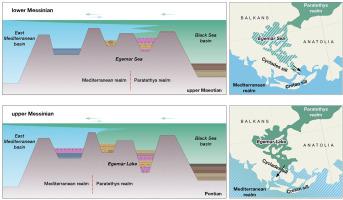当前位置:
X-MOL 学术
›
Earth Sci. Rev.
›
论文详情
Our official English website, www.x-mol.net, welcomes your feedback! (Note: you will need to create a separate account there.)
Changing seas in the late Miocene Northern Aegean: A Paratethyan approach to Mediterranean basin evolution
Earth-Science Reviews ( IF 12.1 ) Pub Date : 2020-11-01 , DOI: 10.1016/j.earscirev.2020.103386 Wout Krijgsman , Dan V. Palcu , Federico Andreetto , Marius Stoica , Oleg Mandic
Earth-Science Reviews ( IF 12.1 ) Pub Date : 2020-11-01 , DOI: 10.1016/j.earscirev.2020.103386 Wout Krijgsman , Dan V. Palcu , Federico Andreetto , Marius Stoica , Oleg Mandic

|
Abstract The Northern Aegean region evolved during the Miocene as a restricted land-locked basin with small ephemeral connections to both the Eastern Paratethys (former Black Sea) and Mediterranean. Its biostratigraphic data show mixed Paratethys-Mediterranean components, but the Paratethys fauna has generally been neglected for chronologic reconstructions. Here, we review this biostratigraphic data from a Paratethyan perspective and present revised paleogeographic reconstructions of the Northern Aegean throughout the late Miocene. In the Tortonian, all sub-basins show mainly fluvio-deltaic terrestrial environments with a series of scattered lakes that are predominantly fed by local rivers and short-lived Paratethys connections. The first persisting marine conditions, still alternating with brackish Paratethyan environments, indicate a middle Messinian (late Maeotian) age (6.9–6.1 Ma), when the region formed a semi-isolated (Egemar) sea with multiple marine influxes. The termination of marine conditions is very well documented by a marked palaeoenvironmental change to the brackish water environments that correlate to the Maeotian/Pontian boundary (6.1 Ma) in Eastern Paratethys. During the Messinian Salinity crisis (5.97–5.33 Ma), the northern Aegean was a brackish water system (Lake Egemar) that formed a passageway for Paratethyan overspill waters towards the Mediterranean. We conclude that the thick evaporites of the Northern Aegean domain do not reflect the classic Mediterranean MSC sequences, but are more likely related to older (Badenian or Maeotian) salinity incursions.
中文翻译:

中新世晚期北爱琴海的变化:地中海盆地演化的Paratethyan方法
摘要 北爱琴海地区在中新世演化为一个受限的内陆盆地,与东帕拉提提斯(前黑海)和地中海有着短暂的联系。它的生物地层数据显示出Paratethys-Mediterranean 的混合成分,但Paratethys 动物群在年代学重建中通常被忽略。在这里,我们从 Paratethyan 的角度回顾了这些生物地层数据,并展示了整个晚中新世北爱琴海的修订古地理重建。在 Tortonian,所有子流域主要显示河流三角洲陆地环境,有一系列分散的湖泊,主要由当地河流和短命的 Paratethys 连接补给。第一个持续存在的海洋条件,仍然与微咸的帕拉提亚环境交替,表明中墨西尼(Maeotian 晚期)时代(6.9-6.1 Ma),当时该地区形成了一个半孤立的(Egemar)海,有多个海洋涌入。与东帕拉提提斯的 Maeotian/Pontian 边界(6.1 Ma)相关的微咸水环境的显着古环境变化已经很好地记录了海洋条件的终止。在墨西拿盐度危机(5.97-5.33 Ma)期间,爱琴海北部是一个咸水系统(埃格马尔湖),形成了帕拉提亚溢出水流向地中海的通道。我们得出的结论是,爱琴海北部区域的厚蒸发岩并不反映经典的地中海 MSC 序列,但更有可能与较早的(巴登或梅奥)盐度入侵有关。当该地区形成一个半孤立的(Egemar)海时,有多次海洋涌入。与东帕拉提提斯的 Maeotian/Pontian 边界(6.1 Ma)相关的微咸水环境的显着古环境变化已经很好地记录了海洋条件的终止。在墨西拿盐度危机(5.97-5.33 Ma)期间,爱琴海北部是一个咸水系统(埃格马尔湖),形成了帕拉提亚溢出水流向地中海的通道。我们得出的结论是,爱琴海北部区域的厚蒸发岩并不反映经典的地中海 MSC 序列,但更有可能与较早的(巴德尼亚或梅奥蒂亚)盐度入侵有关。当该地区形成一个半孤立的(Egemar)海时,有多次海洋涌入。与东帕拉提提斯的 Maeotian/Pontian 边界(6.1 Ma)相关的微咸水环境的显着古环境变化已经很好地记录了海洋条件的终止。在墨西拿盐度危机(5.97-5.33 Ma)期间,爱琴海北部是一个咸水系统(埃格马尔湖),形成了帕拉提亚溢出水流向地中海的通道。我们得出的结论是,爱琴海北部区域的厚蒸发岩并不反映经典的地中海 MSC 序列,但更有可能与较早的(巴德尼亚或梅奥蒂亚)盐度入侵有关。与东帕拉提提斯的 Maeotian/Pontian 边界(6.1 Ma)相关的微咸水环境的显着古环境变化已经很好地记录了海洋条件的终止。在墨西拿盐度危机(5.97-5.33 Ma)期间,爱琴海北部是一个咸水系统(埃格马尔湖),形成了帕拉提亚溢出水流向地中海的通道。我们得出的结论是,爱琴海北部区域的厚蒸发岩并不反映经典的地中海 MSC 序列,但更有可能与较早的(巴登或梅奥)盐度入侵有关。与东帕拉提提斯的 Maeotian/Pontian 边界(6.1 Ma)相关的微咸水环境的显着古环境变化已经很好地记录了海洋条件的终止。在墨西拿盐度危机(5.97-5.33 Ma)期间,爱琴海北部是一个咸水系统(埃格马尔湖),形成了帕拉提亚溢出水流向地中海的通道。我们得出的结论是,爱琴海北部区域的厚蒸发岩并不反映经典的地中海 MSC 序列,但更有可能与较早的(巴德尼亚或梅奥蒂亚)盐度入侵有关。爱琴海北部是一个咸水系统(埃格玛湖),形成了帕拉提亚溢出水流向地中海的通道。我们得出的结论是,爱琴海北部区域的厚蒸发岩并不反映经典的地中海 MSC 序列,但更有可能与较早的(巴登或梅奥)盐度入侵有关。爱琴海北部是一个咸水系统(埃格马尔湖),它形成了帕拉提亚溢出水流向地中海的通道。我们得出的结论是,爱琴海北部区域的厚蒸发岩并不反映经典的地中海 MSC 序列,但更有可能与较早的(巴德尼亚或梅奥蒂亚)盐度入侵有关。
更新日期:2020-11-01
中文翻译:

中新世晚期北爱琴海的变化:地中海盆地演化的Paratethyan方法
摘要 北爱琴海地区在中新世演化为一个受限的内陆盆地,与东帕拉提提斯(前黑海)和地中海有着短暂的联系。它的生物地层数据显示出Paratethys-Mediterranean 的混合成分,但Paratethys 动物群在年代学重建中通常被忽略。在这里,我们从 Paratethyan 的角度回顾了这些生物地层数据,并展示了整个晚中新世北爱琴海的修订古地理重建。在 Tortonian,所有子流域主要显示河流三角洲陆地环境,有一系列分散的湖泊,主要由当地河流和短命的 Paratethys 连接补给。第一个持续存在的海洋条件,仍然与微咸的帕拉提亚环境交替,表明中墨西尼(Maeotian 晚期)时代(6.9-6.1 Ma),当时该地区形成了一个半孤立的(Egemar)海,有多个海洋涌入。与东帕拉提提斯的 Maeotian/Pontian 边界(6.1 Ma)相关的微咸水环境的显着古环境变化已经很好地记录了海洋条件的终止。在墨西拿盐度危机(5.97-5.33 Ma)期间,爱琴海北部是一个咸水系统(埃格马尔湖),形成了帕拉提亚溢出水流向地中海的通道。我们得出的结论是,爱琴海北部区域的厚蒸发岩并不反映经典的地中海 MSC 序列,但更有可能与较早的(巴登或梅奥)盐度入侵有关。当该地区形成一个半孤立的(Egemar)海时,有多次海洋涌入。与东帕拉提提斯的 Maeotian/Pontian 边界(6.1 Ma)相关的微咸水环境的显着古环境变化已经很好地记录了海洋条件的终止。在墨西拿盐度危机(5.97-5.33 Ma)期间,爱琴海北部是一个咸水系统(埃格马尔湖),形成了帕拉提亚溢出水流向地中海的通道。我们得出的结论是,爱琴海北部区域的厚蒸发岩并不反映经典的地中海 MSC 序列,但更有可能与较早的(巴德尼亚或梅奥蒂亚)盐度入侵有关。当该地区形成一个半孤立的(Egemar)海时,有多次海洋涌入。与东帕拉提提斯的 Maeotian/Pontian 边界(6.1 Ma)相关的微咸水环境的显着古环境变化已经很好地记录了海洋条件的终止。在墨西拿盐度危机(5.97-5.33 Ma)期间,爱琴海北部是一个咸水系统(埃格马尔湖),形成了帕拉提亚溢出水流向地中海的通道。我们得出的结论是,爱琴海北部区域的厚蒸发岩并不反映经典的地中海 MSC 序列,但更有可能与较早的(巴德尼亚或梅奥蒂亚)盐度入侵有关。与东帕拉提提斯的 Maeotian/Pontian 边界(6.1 Ma)相关的微咸水环境的显着古环境变化已经很好地记录了海洋条件的终止。在墨西拿盐度危机(5.97-5.33 Ma)期间,爱琴海北部是一个咸水系统(埃格马尔湖),形成了帕拉提亚溢出水流向地中海的通道。我们得出的结论是,爱琴海北部区域的厚蒸发岩并不反映经典的地中海 MSC 序列,但更有可能与较早的(巴登或梅奥)盐度入侵有关。与东帕拉提提斯的 Maeotian/Pontian 边界(6.1 Ma)相关的微咸水环境的显着古环境变化已经很好地记录了海洋条件的终止。在墨西拿盐度危机(5.97-5.33 Ma)期间,爱琴海北部是一个咸水系统(埃格马尔湖),形成了帕拉提亚溢出水流向地中海的通道。我们得出的结论是,爱琴海北部区域的厚蒸发岩并不反映经典的地中海 MSC 序列,但更有可能与较早的(巴德尼亚或梅奥蒂亚)盐度入侵有关。爱琴海北部是一个咸水系统(埃格玛湖),形成了帕拉提亚溢出水流向地中海的通道。我们得出的结论是,爱琴海北部区域的厚蒸发岩并不反映经典的地中海 MSC 序列,但更有可能与较早的(巴登或梅奥)盐度入侵有关。爱琴海北部是一个咸水系统(埃格马尔湖),它形成了帕拉提亚溢出水流向地中海的通道。我们得出的结论是,爱琴海北部区域的厚蒸发岩并不反映经典的地中海 MSC 序列,但更有可能与较早的(巴德尼亚或梅奥蒂亚)盐度入侵有关。



























 京公网安备 11010802027423号
京公网安备 11010802027423号